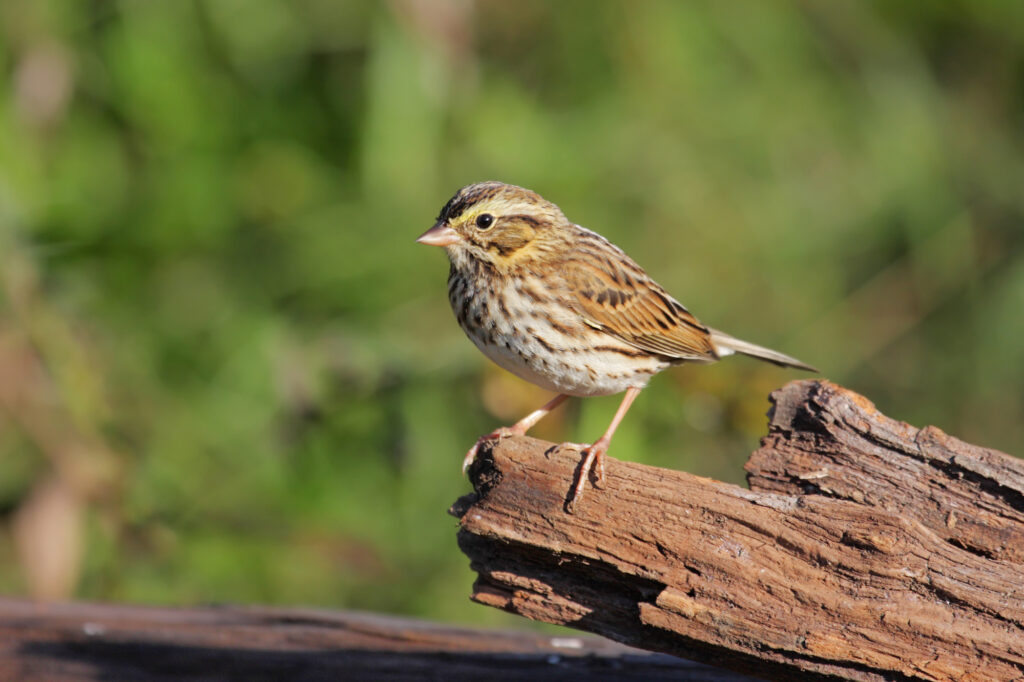Whether you’re a local or just visiting North Carolina, there are plenty of sparrows to be seen throughout the state, in every season.
In the winter, the Atlantic coastal plain and the central Piedmont regions are full of sparrows that have migrated south to enjoy the milder climate here.
In summer, many sparrows leave the state for more northerly breeding grounds, but the cooler climate of the Blue Ridge Mountains offers nesting grounds for several species, too.
A great way to see sparrows up close is to offer them their favorite seeds at your backyard bird feeder during the winter. A bird bath or garden pond is also a valuable resource for sparrows, especially during dry weather.
In this guide, I’m going to be sharing some fascinating facts about these sparrows’ local ranges and migratory patterns, as well as offering my top tips on how to identify each species of this sometimes tricky family of birds!
Sparrows in North Carolina, Starting with the Most Common
Eastern Towhee

- Species Name: Pipilo erythrophthalmus
- Length: 6.8-8.2 in (17.3-20.8 cm)
- Weight: 1.1-1.8 oz (32-52 g)
- Wingspan: 7.9-11.0 in (20-28 cm)
Of all the many sparrows in North Carolina, the eastern towhee is most frequently spotted. But that doesn’t necessarily mean that they’re the most numerous!
These large, colorful members of the New World Sparrow family are more conspicuous than some of their cousins and so are bound to be reported more often. While you can see eastern towhees in all seasons throughout North Carolina, they’re slightly more common here during the summer months.
Their black upper body, white breast, and rusty red flanks make them one of the most ornate and colorful sparrows in North America. They can often be found scratching about in the undergrowth or below bird feeders in search of seeds, nuts, insects, and other tasty morsels.
Song Sparrow

- Species Name: Melospiza melodia
- Length: 4.7-6.7 in (12-17 cm)
- Weight: 0.4-1.9 oz (12-53 g)
- Wingspan: 7.1-9.4 in (18-24 cm)
Song sparrows may be the most common sparrow species in North America, but they’re number two in North Carolina.
While they can be difficult to distinguish from other brown-streaked sparrows by sight, they’re also one of the most vocal of all sparrows, so learning their song is a great way to get a positive identification.
Whereas the western part of North Carolina is home to song sparrows throughout the year, the eastern third of the state only hosts these beautiful birds during the colder months.
Song sparrows especially enjoy habitats near water, but will readily come to dine at your backyard bird feeder. They may also appreciate a garden pond, or a purpose-made bird bath to drink from and wash off in.
White-throated Sparrow
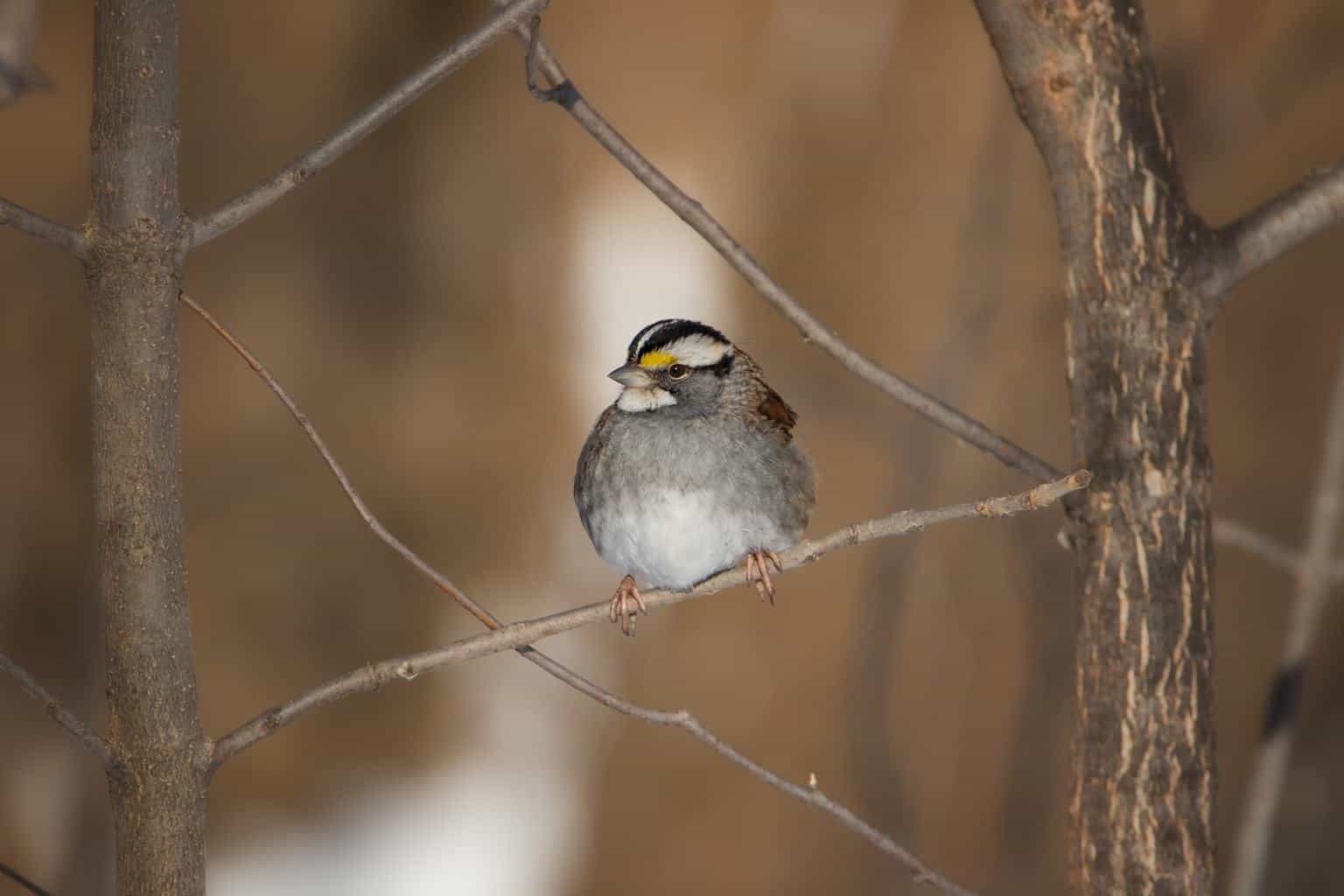
- Species Name: Zonotrichia albicollis
- Length: 6.3-7.1 in (16-18 cm)
- Weight: 0.8-1.1 oz (22-32 g)
- Wingspan: 7.9-9.1 in (20-23 cm)
Despite only being a winter visitor in North Carolina, the sheer number of white-throated sparrows that visit the state during the colder months makes them the third-most common sparrow in the state overall.
These medium-sized sparrows have distinctive black and white (or light brown) stripes on the crown of their heads, yellow eyebrows, and light gray-colored chests. The melancholic whistling ‘Old Sam Peabody (Peabody, Peabody)’ song of this common bird is also very singular and easy to recognize.
This sparrow enjoys flocking during the winter months and will often join mixed flocks with other sparrows. They’re typically seen in mixed woods and hedges but can be tempted to visit backyards in search of food as well.
Chipping Sparrow
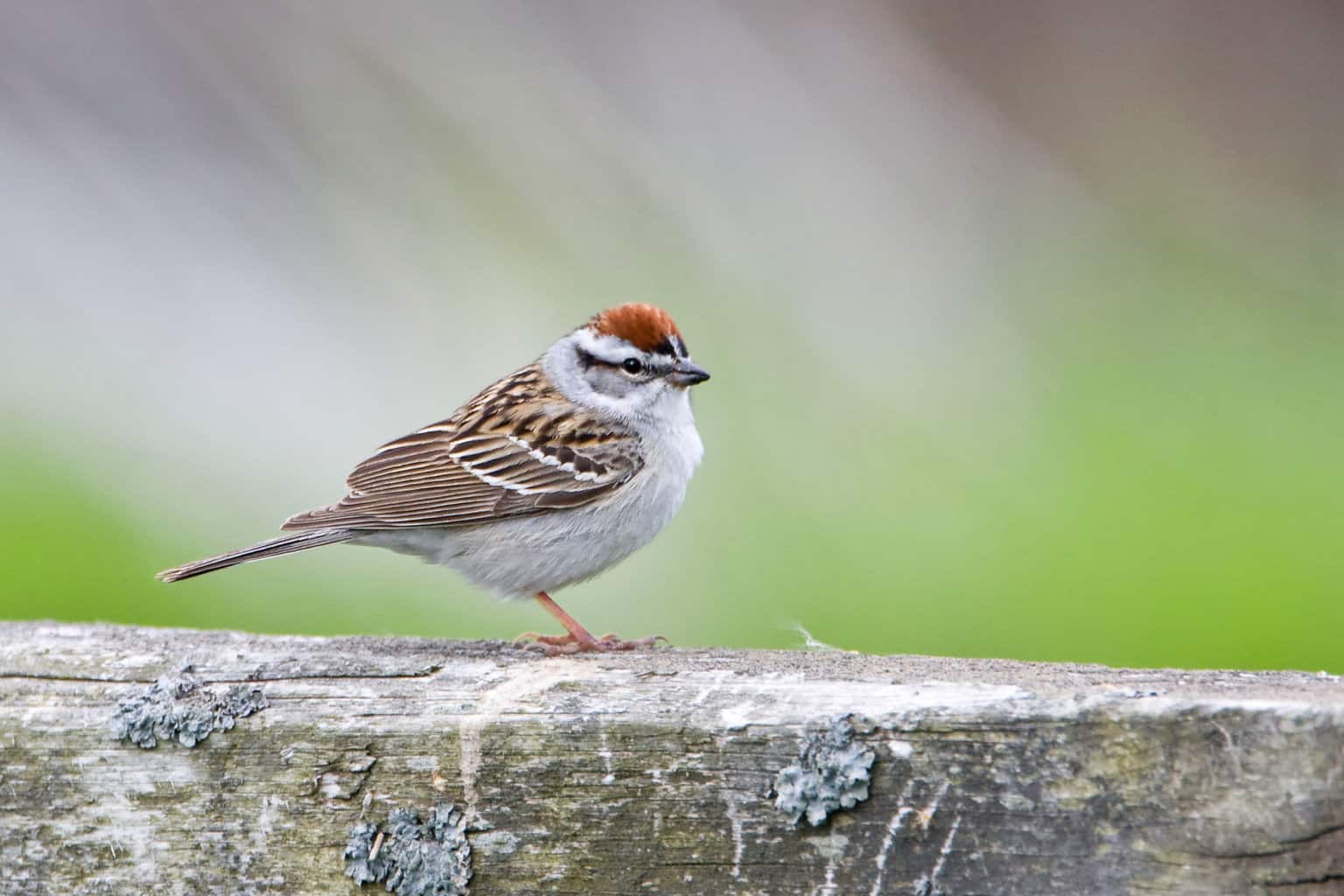
- Species Name: Spizella passerina
- Length: 4.7-5.9 in (12-15 cm)
- Weight: 0.4-0.5 oz (11-16 g)
- Wingspan: 8.3 in (21 cm)
The tiny chipping sparrow is one of the most widespread sparrows in North America. With a scattered breeding range stretching from Mexico to Alaska, they typically fly around in small flocks, often mixed with other sparrows.
You can find chipping sparrows all year round in North Carolina but in rather different places. In summer they like to nest in open woodlands and leafy suburbs, but in winter they favor open grasslands with scattered bushes and trees. They can also be attracted to visit backyard bird feeders.
Chipping sparrows are closely related to clay-colored sparrows and Brewer’s sparrows, but can be distinguished by their highly pronounced eye line and rusty crown. Their trilling call is also one of the noisiest and most persistent in the woodland spring chorus, so it’s a useful one to recognize!
Dark-eyed Junco
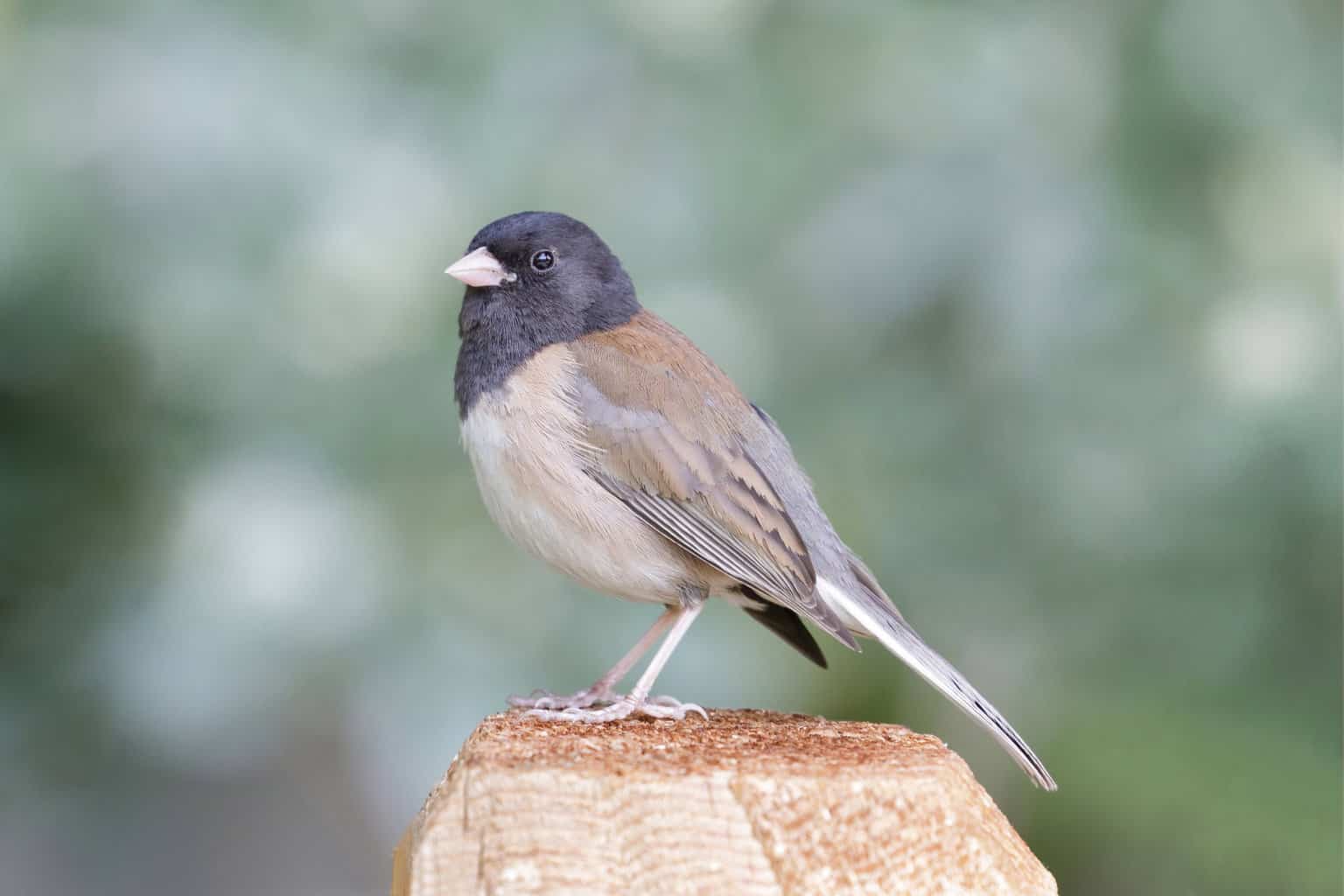
- Species Name: Junco hyemalis
- Length: 5.5-6.3 in (14-16 cm)
- Weight: 0.6-1.1 oz (18-30 g)
- Wingspan: 7.1-9.8 in (18-25 cm)
The subspecies of dark-eyed junco you’ll see in North Carolina will almost certainly be the aptly-named slate-colored variety. The red-bodied Oregon subspecies is only a very occasional vagrant here.
Male slate-colored dark-eyed juncos have a dark gray upper body, and a white chest, but females can vary from having a slight brown tint to a full-light brown upper body and white undersides.
Sometimes also known as the ‘snow bird’, dark-eyed juncos are incredibly hardy sparrows that can be seen in every single state of the mainland continent.
Dark-eyed juncos are only winter visitors in North Carolina, except in the Blue Ridge mountain range in the west, which remains sufficiently cool for these birds to breed during the summer, too.
Field Sparrow
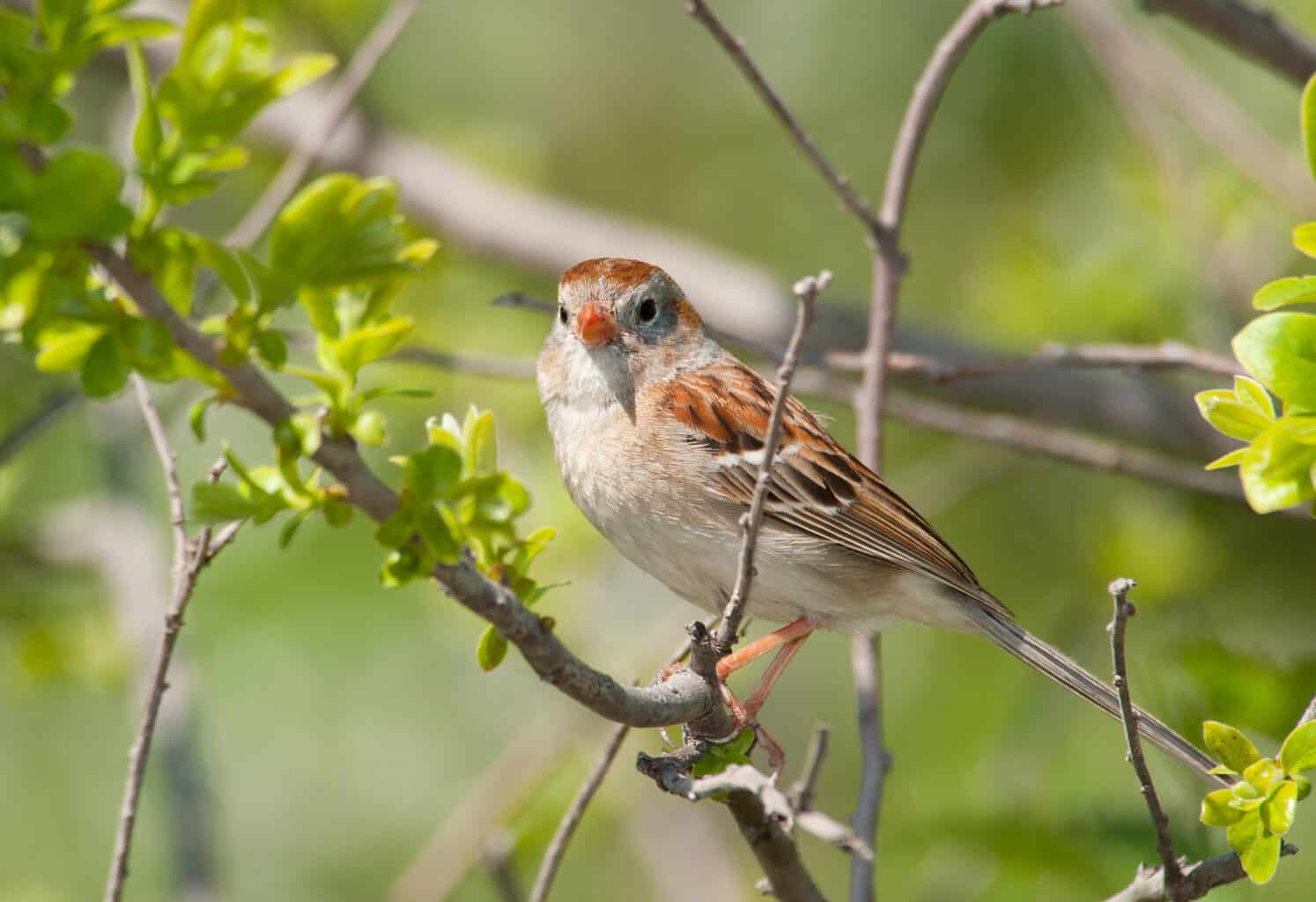
- Scientific Name: Spizella pusilla
- Length: 4.7-5.9 in (12-15 cm)
- Weight: 0.4-0.6 oz (11-15 g)
- Wingspan: 7.9 in (20 cm)
Field sparrows are either pinkish-brown or grayish sparrows in the same family as the chipping sparrow. They can be told apart from their cousins by their longer tails and pink bills. As their name suggests, they prefer life out in the meadows to areas nearby human habitation.
A good way to identify this shy bird is by its high-pitched trill that sounds a bit like a bouncing ball coming to a stop! Males are especially vocal during the breeding season when they’ll often sing from a high perch during the early morning.
These native birds can be seen in North Carolina throughout the year. Their nests are made from grass, and their eggs take around two weeks to hatch. The young only take around a week or so to fledge.
House Sparrow

- Scientific Name: Passer domesticus
- Length: 5.9-6.7 in (15-17 cm)
- Weight: 0.9-1.1 oz (27-30 g)
- Wingspan: 7.5-9.8 in (19-25 cm)
The house sparrow is the only sparrow that’s been recorded in every state of the USA, including Hawaii!
The irony is that house sparrows are not even native birds in America! They were introduced to New York City in 1852 from Europe to control the Linden moth population and quickly became considered a pest themselves.
Because they’re not related to native sparrows, house sparrows behave quite differently. They don’t migrate and often dominate the nesting grounds of native birds.
Nevertheless, house sparrows are one of the tamest and most endearing sparrows, and can even be trained to eat from your hand! Females are very plain looking but are usually closely guarded by adult males with distinctive black throats.
Swamp Sparrow
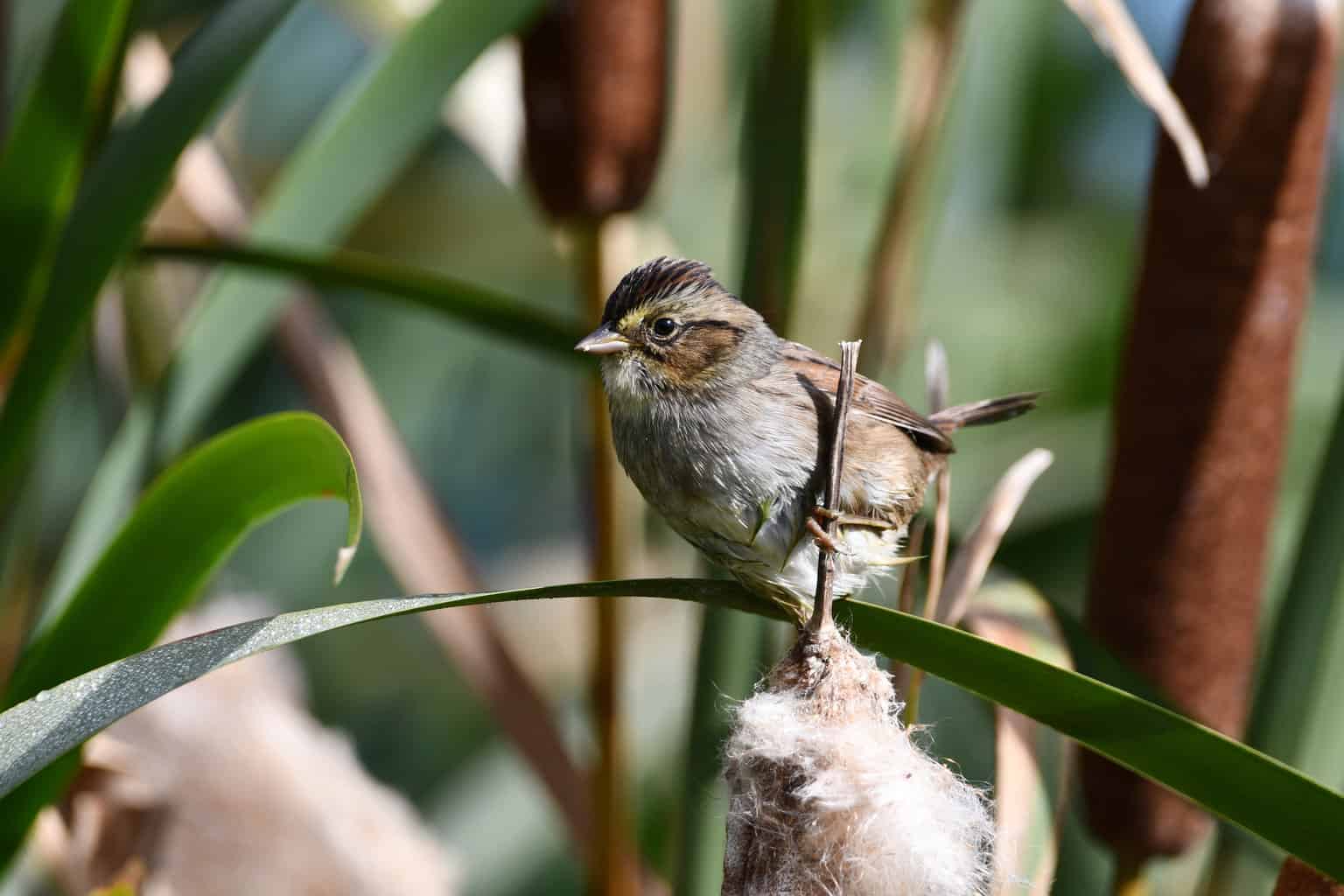
- Species Name: Melospiza georgiana
- Length: 4.7-5.9 in (12-15 cm)
- Weight: 0.5-0.8 oz (15-23 g)
- Wingspan: 7.1-7.5 in (18-19 cm)
True to their name, swamp sparrows are primarily wetland birds, although they may spend time in drier, weedy fields during the winter, too.
It’s during the colder months that swamp sparrows can be seen in North Carolina before they migrate to their more northerly wetland breeding grounds.
The brown cap and black eye line are the most commonly described field marks of the swamp sparrow, but they also have a singular call which, to my mind, sounds a bit like mocking laughter
Although they’re not regular visitors to backyard bird feeders, you may be able to attract swamp sparrows to your garden by offering them a pond or bird bath to dip in!
Savannah Sparrow
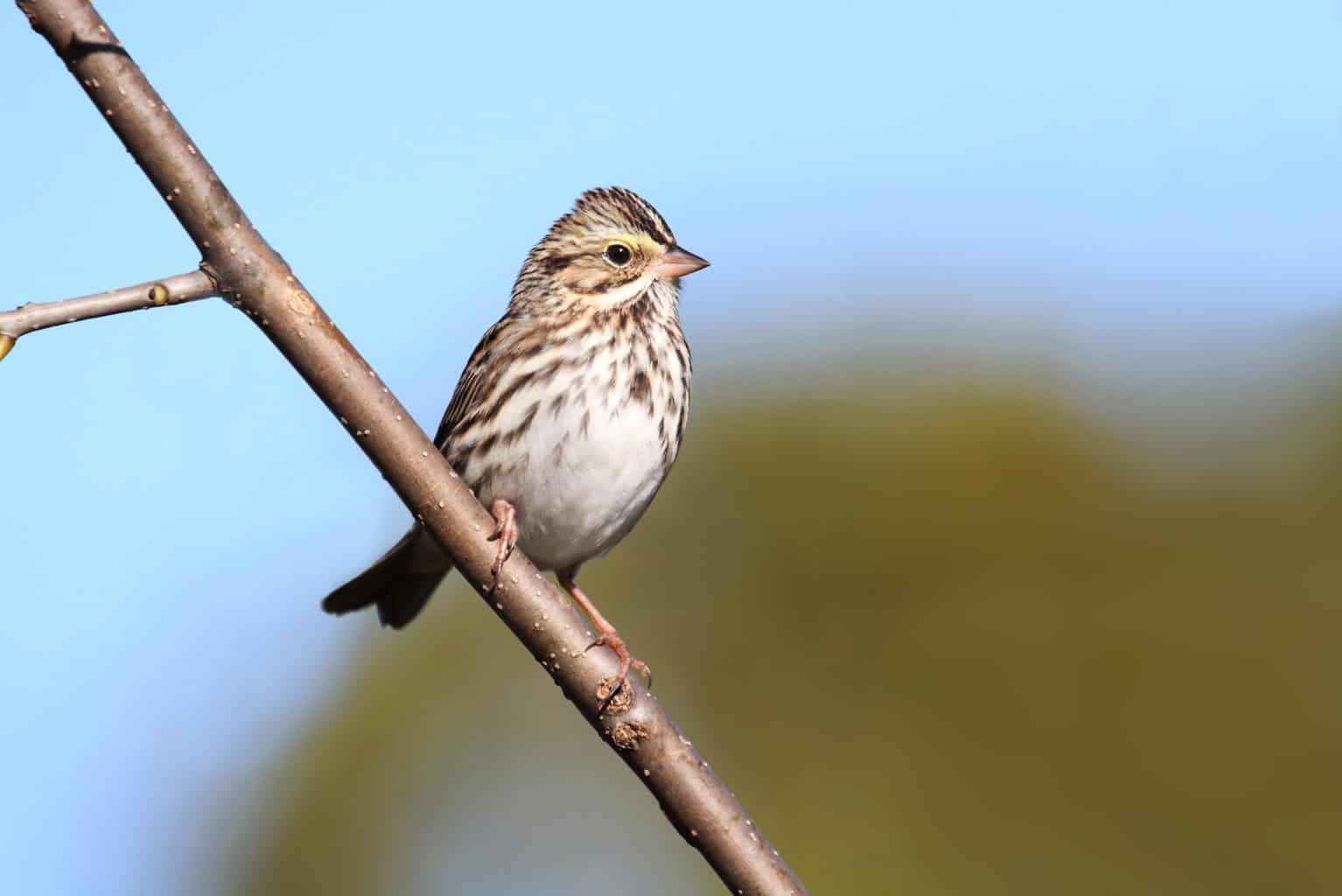
- Scientific Name: Passerculus sandwichensis
- Length: 4.3-5.9 in
- Weight: 0.5-1.0 oz
- Wingspan: 7.9-8.7 in
It can be difficult to distinguish savannah sparrows by sight from other similar species such as song sparrows. Only with a good pair of binoculars will you be able to spot its most defining feature – the subtle yellow streaks above its eyes.
As their name suggests, this sparrow species prefers spending its time in the wilderness rather than in towns and cities, and won’t tend to visit garden bird feeders as many other sparrows do. Instead, this species feeds mainly on insects, which it can be seen chasing down either in short bursts of flight or on the ground.
Savannah sparrows are mostly winter birds in North Carolina and are especially common in the mild region near the coast. There’s yet to be a confirmed nest site discovered, but sightings of these birds carrying food in the spring confirm they must be nesting in the northern counties.
Fox Sparrow

- Scientific Name: Passerella iliaca
- Length: 5.9-7.5 in (15-19 cm)
- Weight: 0.9-1.6 oz (26-44 g)
- Wingspan: 10.5-11.4 in (26.7-29 cm)
Fox sparrows are one of the largest of all sparrow species and appear almost like a small thrush. Their speckled chest and a reddish tint to their brown feathers make them fairly easy to recognize.
The Taiga subspecies of fox sparrow merely use the milder climate of North Carolina as an overwintering ground. For the breeding season, they fly to colder regions including the rocky mountains, and inside the arctic circle to nest.
Although they’re never a common sighting here, you can find fox sparrows scratching about in the undergrowth looking for insects, seeds, and worms during the winter months, much like thrushes do.
Rare Sparrows in North Carolina
The following sparrows are seen by less than 1 in 100 bird watchers in North Carolina, and so can all be considered prized sightings!
White-crowned Sparrow
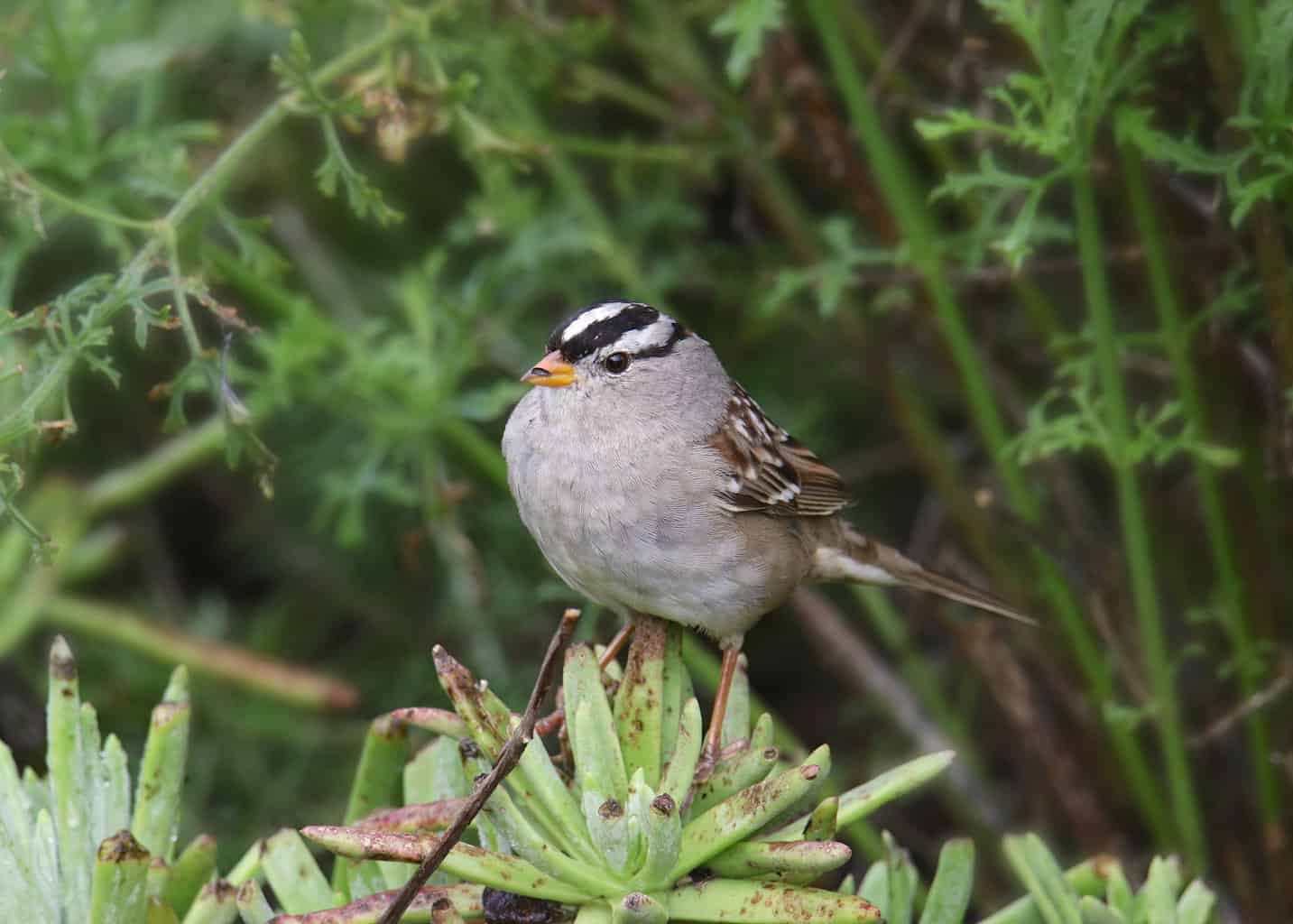
- Scientific Name: Zonotrichia leucophrys
- Length: 5.9-6.3 in (15-16 cm)
- Weight: 0.9-1.0 oz (25-28 g)
- Wingspan: 8.3-9.4 in (21-24 cm)
Despite being one the most common sparrows in more westerly states, white-crowned sparrows make a rare sighting in much of North Carolina.
Interestingly, these hardy birds seem to prefer overwintering in the mountainous west of the state to the eastern plains and are absent in summer altogether.
These largish sparrows are easy to recognize by their black and white striped heads and yellowish bills. They are most regularly seen in weedy areas, near farmlands and brush piles, but rarely near forests.
You can increase your chances of seeing white-crowned sparrows by offering them cracked corn, millet, and other grains at your backyard feeder during the winter months.
Grasshopper Sparrow
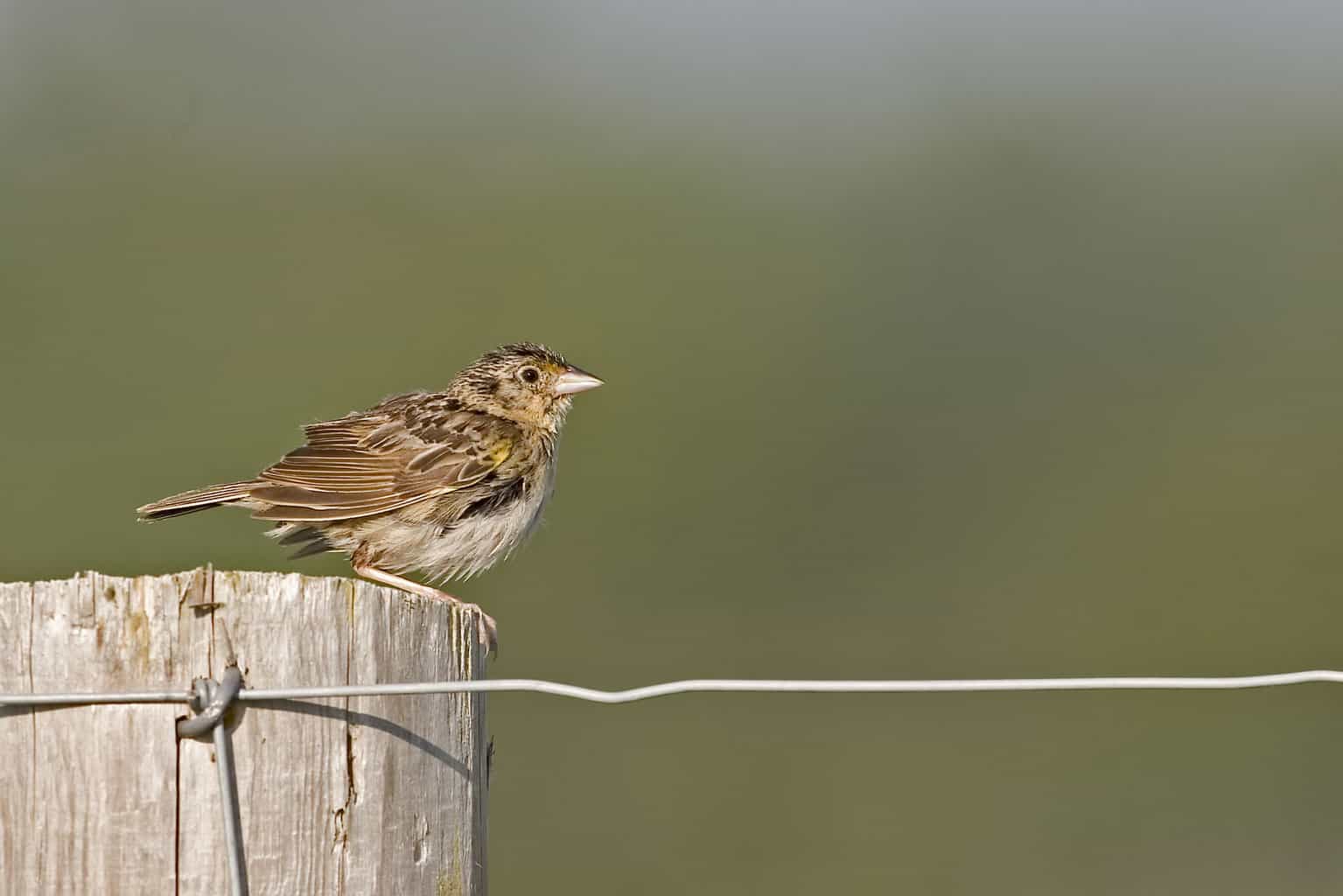
- Species Name: Ammodramus savannarum
- Length: 4.3-4.5 in (10.8-11.5 cm)
- Weight: 0.5-0.7 oz (14-20 g)
- Wingspan: 7.9 in (20 cm)
The grasshopper sparrow is a tiny, yellowish dry grassland bird with an especially large head and bill. Not only do they produce a simple song rather like that of grasshoppers, but they also love to eat them!
Like other grassland birds, grasshopper sparrows are sadly declining at a rapid rate across America, (with an annual decline of 3.48% recorded recently). The loss of wild grasslands to intensive agriculture is thought to be the chief culprit for their demise.
According to the Birds of North Carolina organization, they breed in most parts of the state, but nest sites are disappearing owing to the decline in the grasslands associated with livestock farming.
Its secretive behavior in winter makes it difficult to track, but it is thought to be absent from the western mountains during this time.
Seaside Sparrow
- Scientific Name: Ammospiza maritimus
- Length: 5.1-5.9 in (13-15 cm)
- Weight: 0.7-1.0 oz (19-29 g)
- Wingspan: 7.1-7.9 in (18-20 cm)
The seaside sparrow is a small, gray sparrow with a large bill. True to its name, it’s only found along the coastline (of the Eastern United States), especially around saltwater marshes.
In North Carolina, seaside sparrows are found throughout the year and can be considered a highly localized, rather than extremely rare species. They build their nests out of grass among tall, marshy vegetation.
It uses its particularly long bill for digging up tasty snacks such as insects and crustaceans from deep in the mud! Your best chance of seeing these birds is to go out on the salt marshes at low tide with a pair of decent binoculars.
Vesper Sparrow
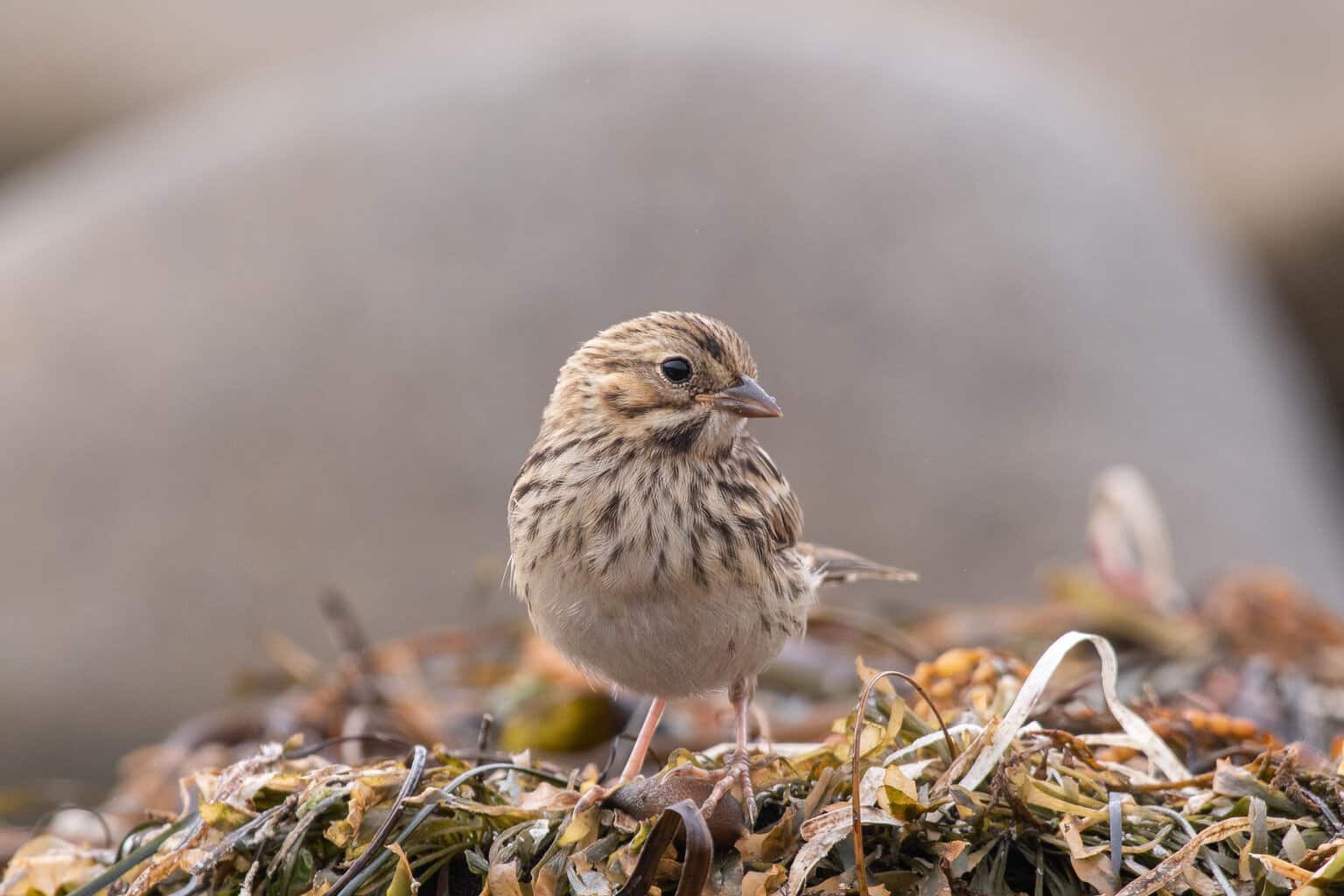
- Scientific Name: Pooecetes gramineus
- Length: 5.1-6.3 in (13-16 cm)
- Weight: 0.7-1.0 oz (20-28 g)
- Wingspan: 9.4 in (24 cm)
The vesper sparrow is similar in appearance to the savannah sparrow, but they’re slightly larger, with a longer tail, and without the yellow wash on their face. They can often be seen perching in the open on wire fences, and typically fly to treetops when disturbed.
Vesper sparrows are a rare sight in North Carolina. The east of the state represents the northern frontier of their winter range, and they’re altogether absent from the west, except for a small breeding population in the Blue Ridge Mountains.
Vesper sparrows numbers have declined by 37 percent during the last 50 years. This is mostly due to habitat loss in both breeding and wintering grounds. Modern farming practices, including pesticide use, hedgerow clearing, and early hay harvesting, have been detrimental.
Bachman’s Sparrow

- Scientific Name: Peucaea aestivalis
- Length: 4.9 – 6 in
- Weight: 0.6 -0.8 oz
- Wingspan: 6.9 – 7.5 in
Bachman’s sparrows are rather indistinct brown sparrows that are solitary and secretive. As their brown and gray plumage camouflages perfectly into their shrubby forest habitats, this rare species should be considered a prized spotting.
The southern parts of the coastal plains are the only place where Bachman’s sparrows can be seen in North Carolina. The state is the northernmost point of its confined range in the southeast of the country.
Unlike most sparrows, Bachman’s sparrows are fairly sedentary and don’t migrate long distances. They like to breed in open pine forests such as those found at Holly Shelter Game Land. They build domed nests hidden among long, dense clumps of grass or bushes.
They are considered near threatened by the IUCN, and it is thought that habitat loss is largely to blame for their decline. Sadly, they are now much rarer in North Carolina than they were a few decades ago.
Lincoln’s Sparrow
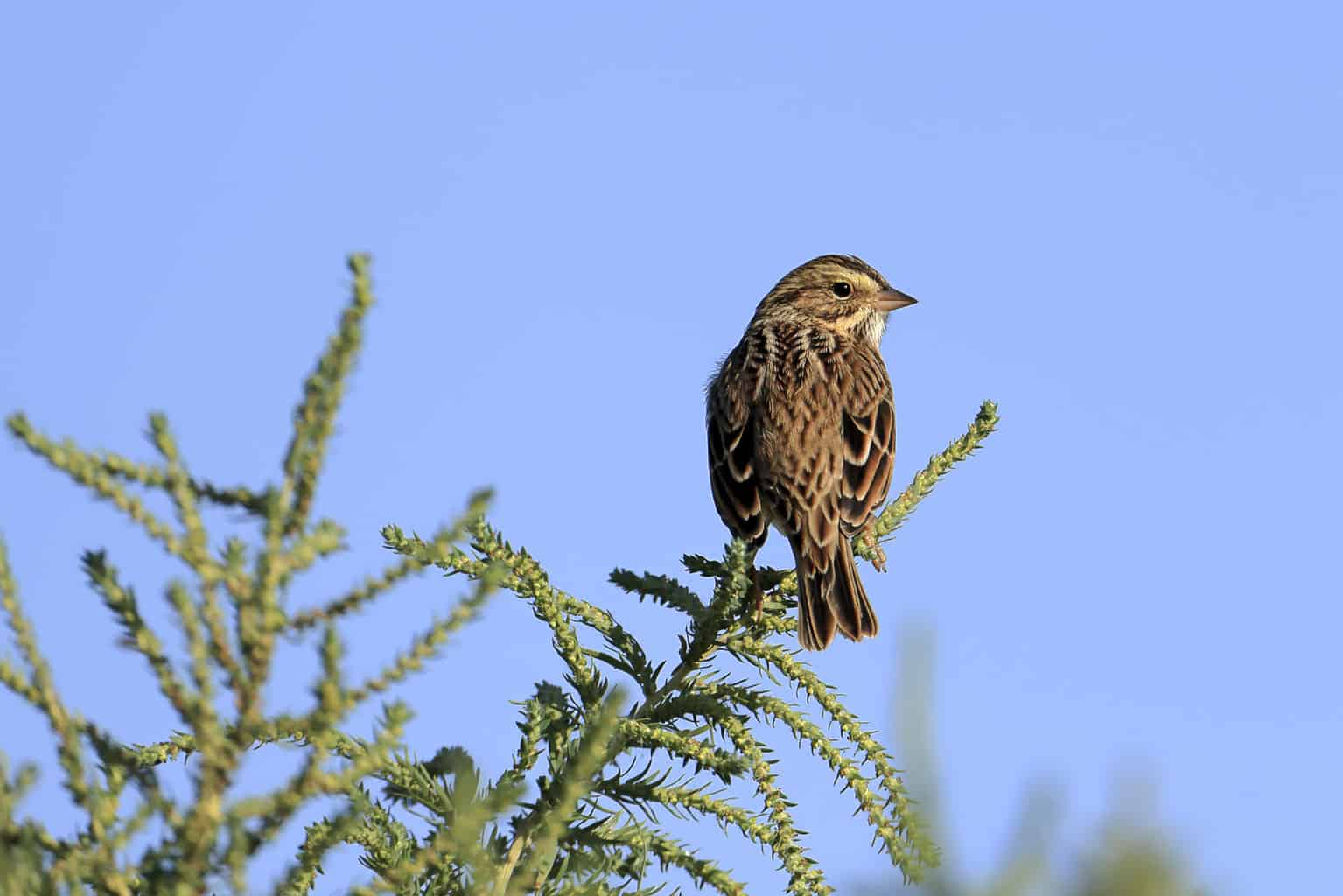
- Scientific Name: Melospiza lincolnii
- Length: 5.1-5.9 in
- Weight: 0.6-0.7 oz
- Wingspan: 7.5-8.7 in
The best way to identify Lincoln’s sparrow is to learn its song. Quite distinct from its cousins the song sparrow and swamp sparrow, Lincoln’s sparrow produces a mellow, soothing, gurgling song that must be one of the sweetest of any songbird in North America.
Like so many other sparrows, it seems, North Carolina is the northernmost tip of Lincoln’s sparrows’ winter range, where they can only be reliably found in mild areas near the coast.
The rest of the state, however, does offer chances to see and hear Lincoln’s sparrows during the migration season. Their migratory range which extends from Central America to the arctic circle means that these birds can be seen passing through much of America during the spring and fall.
Nelson’s Sparrow
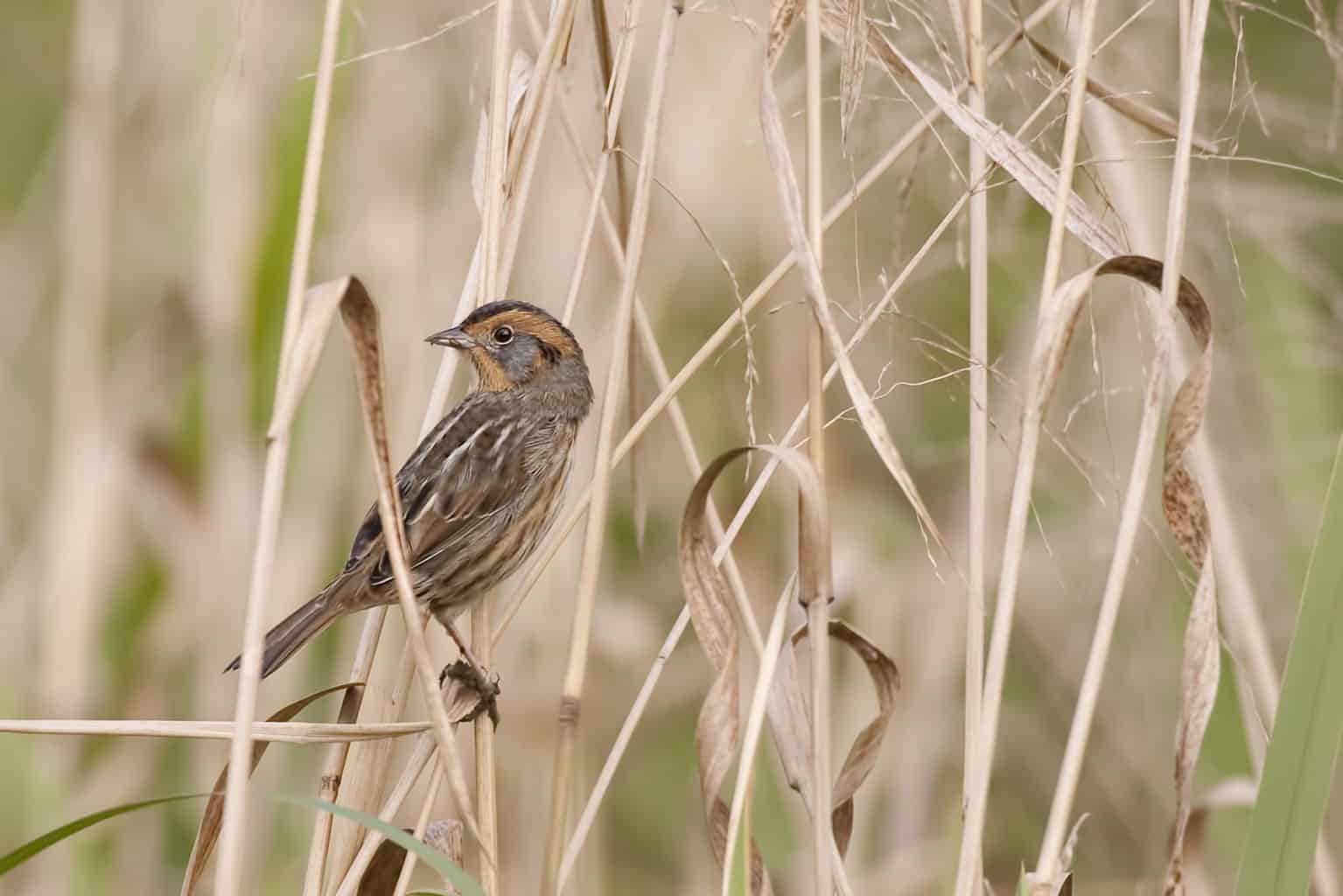
- Scientific Name: Ammospiza nelsoni
- Length: 4.3-5.1 in (11-13 cm)
- Weight: 0.6-0.7 oz (17-21 g)
- Wingspan: 6.5-7.9 in (16.5-20 cm)
Nelson’s sparrows are very similar to saltmarsh sparrows, so much so that they were thought to be the same species until 1989! Previously known as the ‘sharp-tailed sparrow’, the distribution maps had to be redrawn.
It turns out that Nelson’s sparrow can also be found in freshwater habitats, as well as saltwater, unlike its cousin whose populations always hug the coastline.
Nelson’s sparrows can only be found in North Carolina during winter. They breed in the northeastern fringes of the United States, as well as in the upper midwest.
It’s very hard to tell them apart from saltmarsh sparrows by sight, but they can be distinguished from the even rarer LeConte’s sparrows by their longer bill and more orangey color.
Lark Sparrow
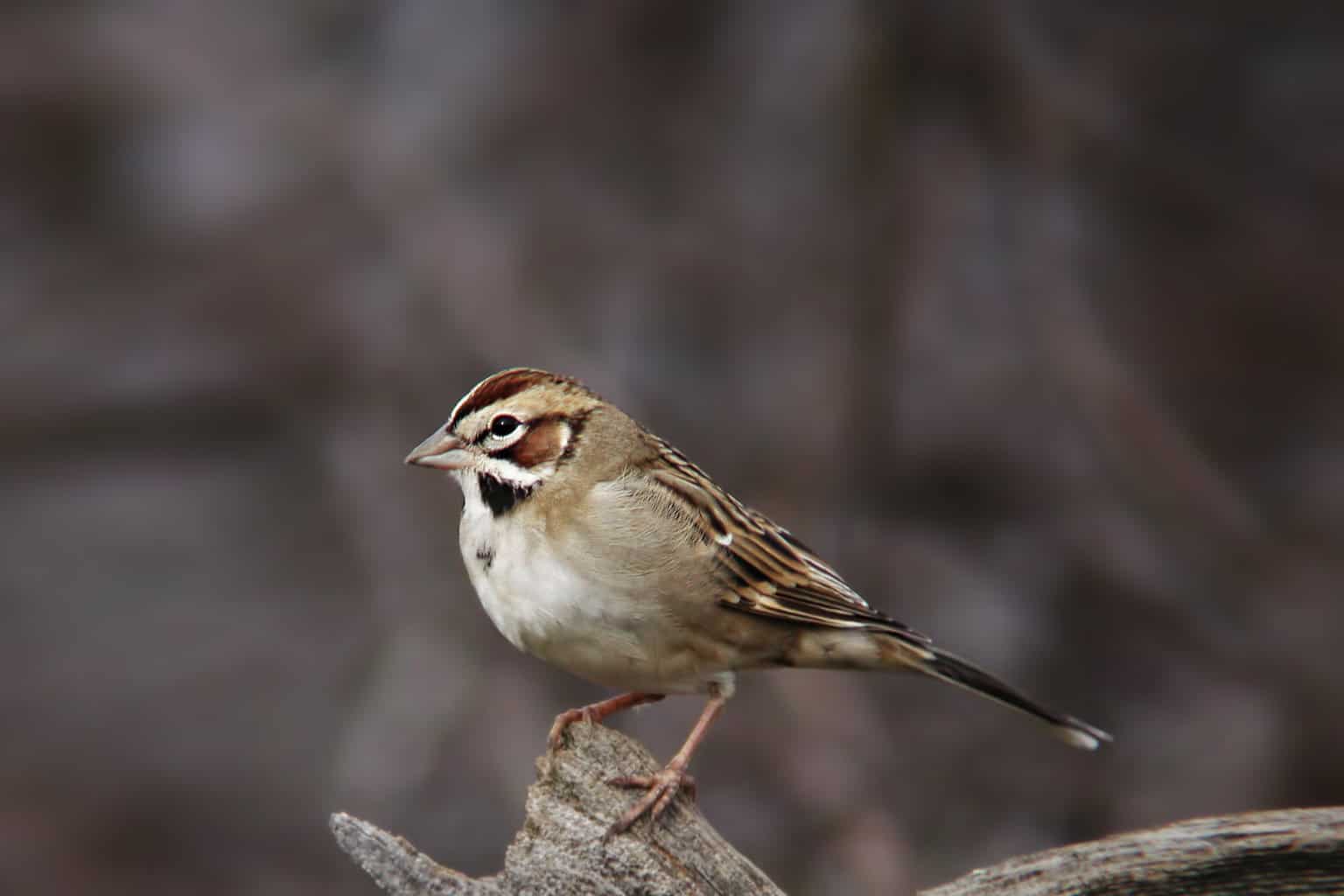
- Scientific Name: Chondestes grammacus
- Length: 5.9-6.7 in (15-17 cm)
- Weight: 0.8-1.2 oz (24-33 g)
- Wingspan: 11.0 in (28 cm)
Lark sparrows are very large sparrows with a broad wingspan. They also have a bright white underside with a dark spot on their chest and white tips on their tail. Closer inspection also reveals distinct black stripes on their face and tan crown feathers.
Although they’re a fairly common species of sparrow further west, lark sparrows are incredibly rare birds in the eastern states. Interestingly, the sandhills of the Carolinas provide one of the only outposts in the east where these sparrows breed.
Fort Liberty and Camp Mackall are two of the few places where the ideal dry, sandy grasslands are available for these birds, who are very particular about their nest sites!
A few lark sparrows may also remain along the coastal plains during the winter.
Saltmarsh Sparrow
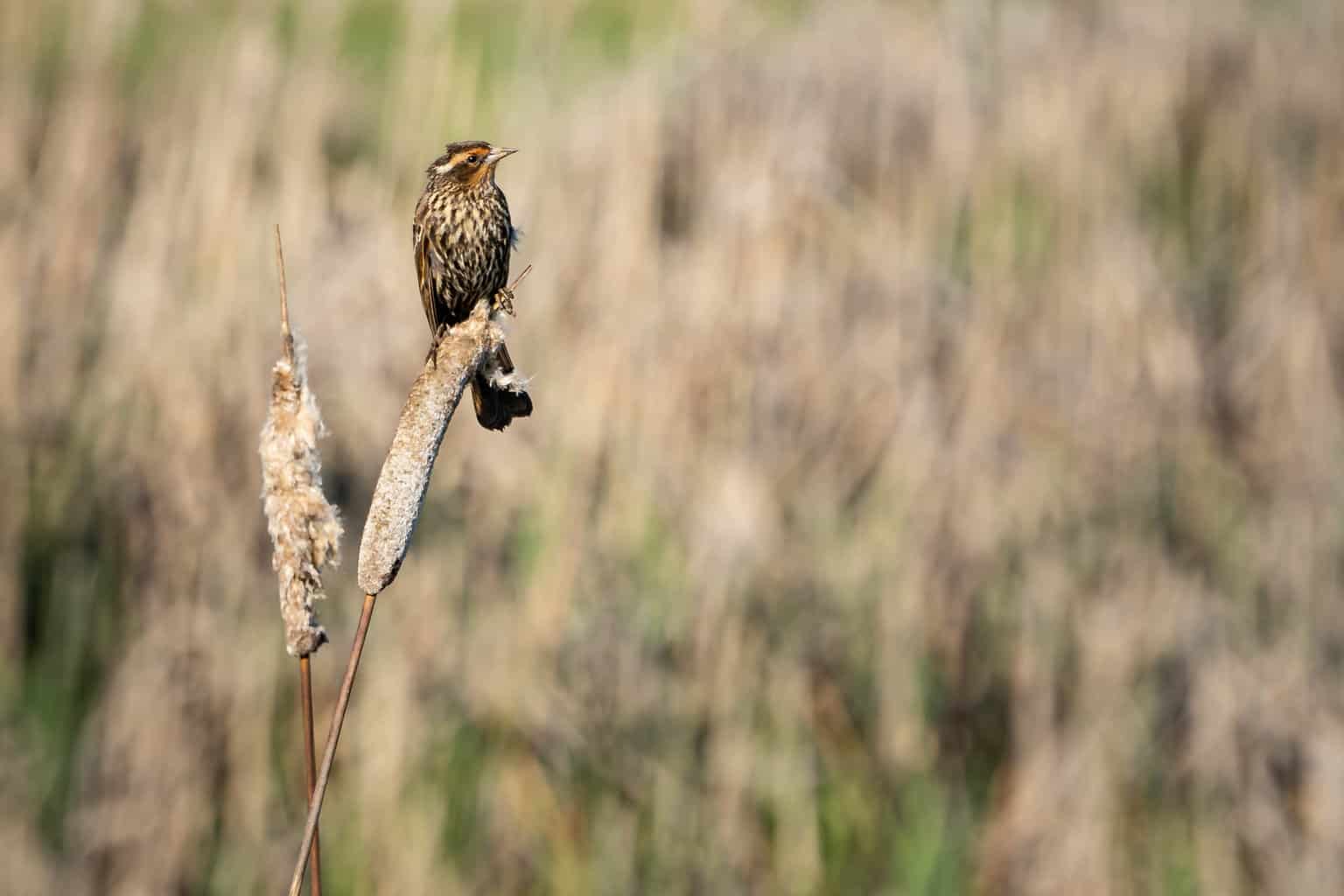
- Scientific Name: Ammospiza caudacuta
- Length: 4.7-5.1 in (12-13 cm)
- Weight: 0.6-0.8 oz (17.1-24.1 g)
- Wingspan: 6.5-7.7 in (16.5-19.5 cm)
Almost indistinguishable from their cousin Nelson’s sparrow, the saltmarsh sparrow actually enjoys a more similar habitat, range, and lifestyle to its other relative, the seaside sparrow.
Both species are long-billed coastal birds of saltmarsh habitats, but saltmarsh sparrows are rather smaller and lack the yellow ‘eyebrows’ of their kin.
Saltmarsh sparrows are chiefly winter birds in North Carolina but interestingly have been spotted in the state during June, too. Despite this, there are still no confirmed reports of them nesting here.
Clay-colored Sparrow
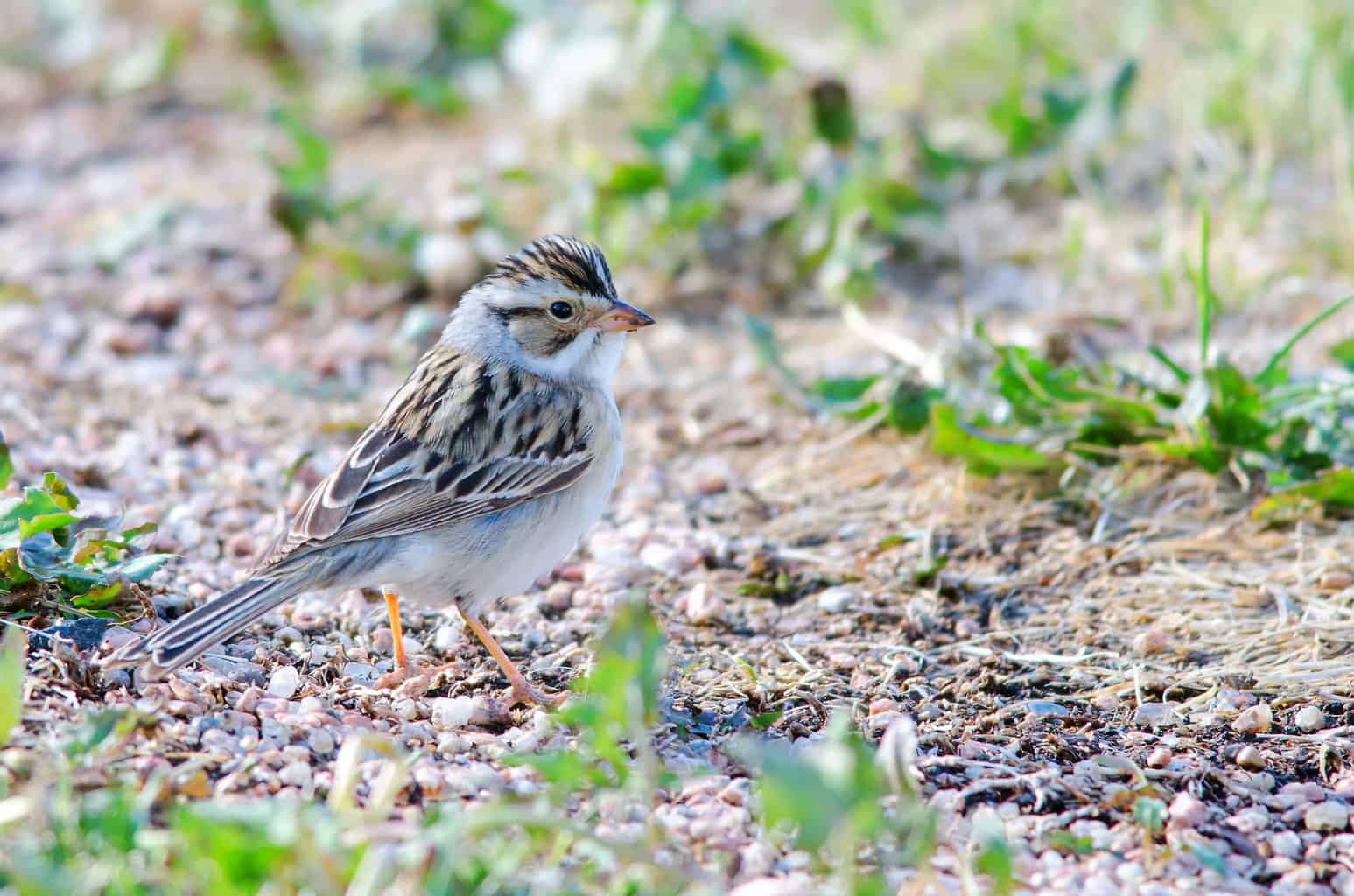
- Scientific Name: Spizella pallida
- Length: 5.1 – 6 in (13 – 15 cm)
- Weight: 0.42 oz (12 g)
- Wingspan: 7.5 in (19 cm)
The name “clay-colored” is only appropriate for this bird in its winter plumage. Between April and August, it sheds the pinkish-brown brown feathers of its underbelly in preference for a clean white front.
While they are locally common, clay-colored sparrows traditionally had a narrow geographical range occupying the central states. In recent decades, they’ve become more widespread, and can now occasionally be spotted along the North Carolina coast right through the winter.
Clay-colored sparrows often mix in flocks with field sparrows and other species that enjoy the same brushy thickets, weedy fields, and hedgerows that they do.
Henslow’s Sparrow
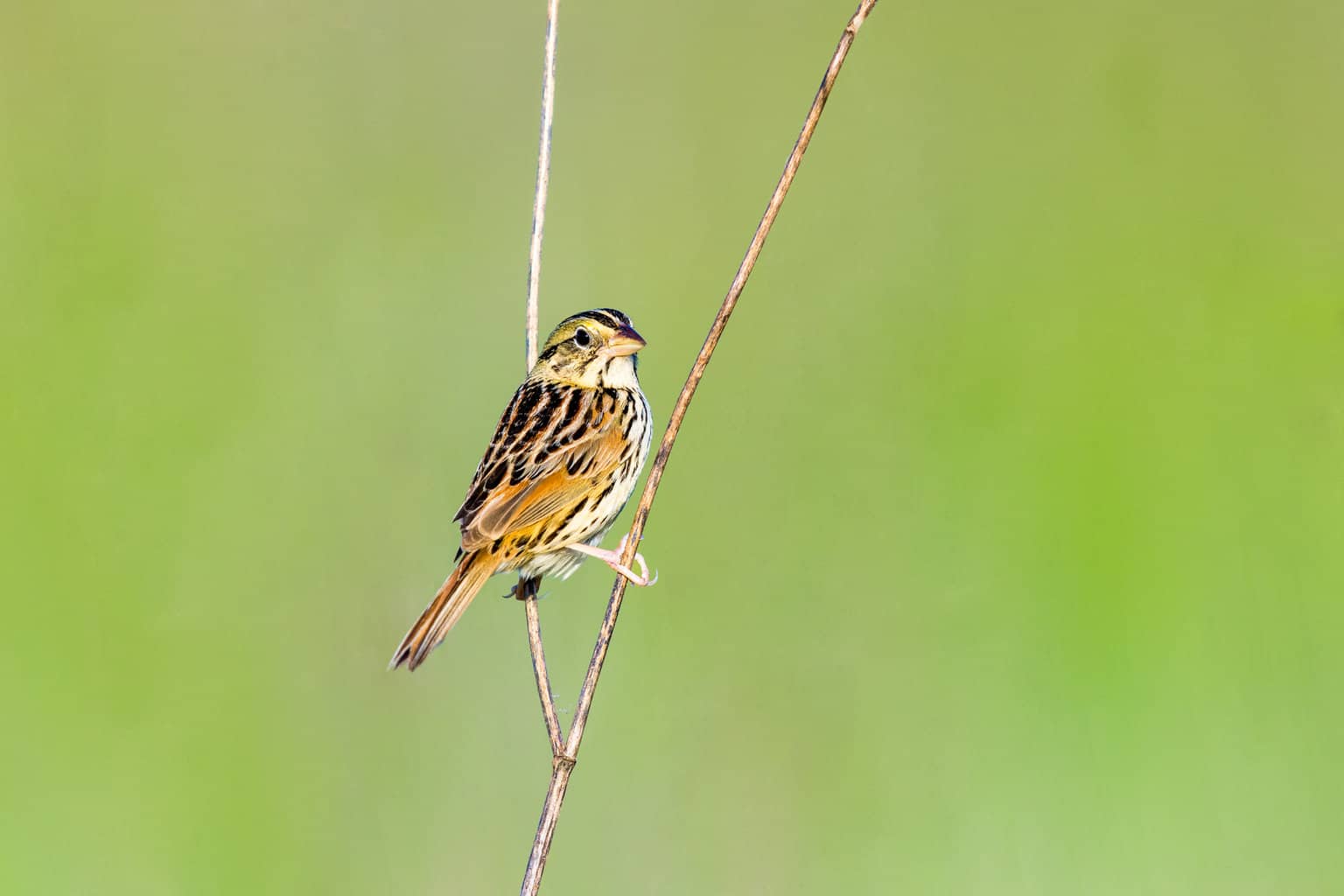
- Species Name: Centronyx henslowii
- Length: 4.75 – 5.25 in (12–13 cm)
- Weight: 0.5 oz (14 g)
- Wingspan: 7 – 7.5 in (18 – 19 cm)
Henslow’s sparrows are very small, short-tailed, and large-headed sparrows with a relatively large beak. Not only are they secretive and difficult to spot, but they’re also one of the rarest sparrows in North America.
Though they used to be more widespread, the loss of damp grassy meadows that this bird relies on has reduced their population to dangerously low numbers.
While there were confirmed records of these birds breeding throughout the state, they can now only be found nesting on the North Carolina coastal plain.
In 2017, the species was reclassified from ‘State Special Concern’ to ‘State Endangered’ to reflect their precarious situation. If you spot one of these endangered birds, be sure to report it to the Birds of North Carolina organization!
LeConte’s Sparrow
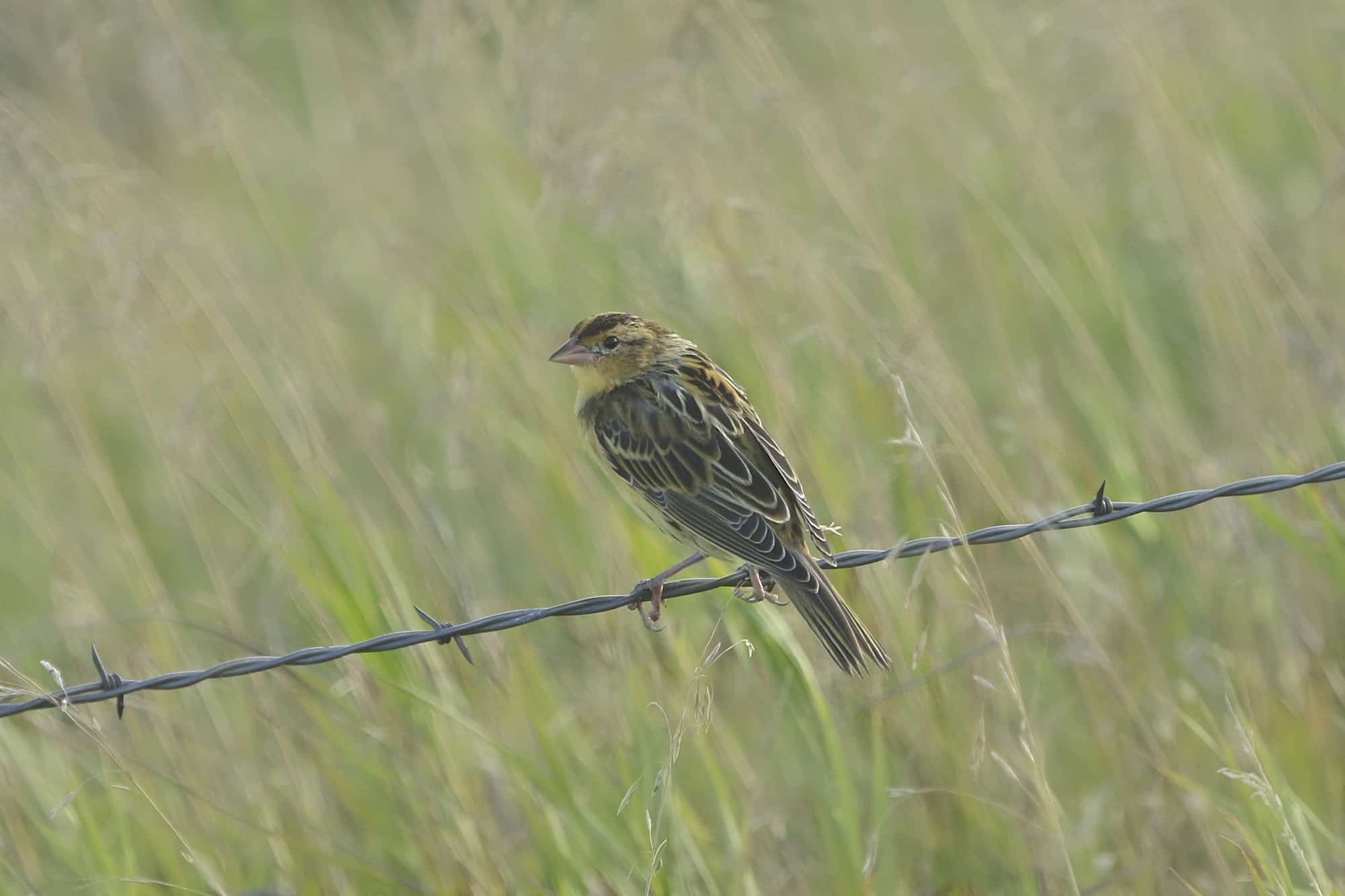
- Species Name: Ammospiza leconteii
- Length: 4.7-5.1 in (12-13 cm)
- Weight: 0.4-0.6 oz (12-16.3 g)
- Wingspan: 6.3-7.1 in (16-18 cm)
Nowhere in America is LeConte’s sparrow particularly common, but they are especially rare in North Carolina. It wasn’t until the late 20th century that these birds were acknowledged as occurring regularly in the state at all!
With more keen eyes on bird populations these days, there is a steady stream of reports of LeConte’s sparrows on the coastal plains, but they are extremely rare elsewhere in North Carolina.
One of the reasons for the infrequent sightings could be how discreet these tiny birds are. Hiding among the tall, damp grasslands that they prefer, they are also easy to confuse with Grasshopper and Henslow’s sparrows.
Unlike grasshopper sparrows, however, LeConte’s has a clean white breast, and compared to Henslow’s, they have a smaller, pointed bill and darker color.
American Tree Sparrow
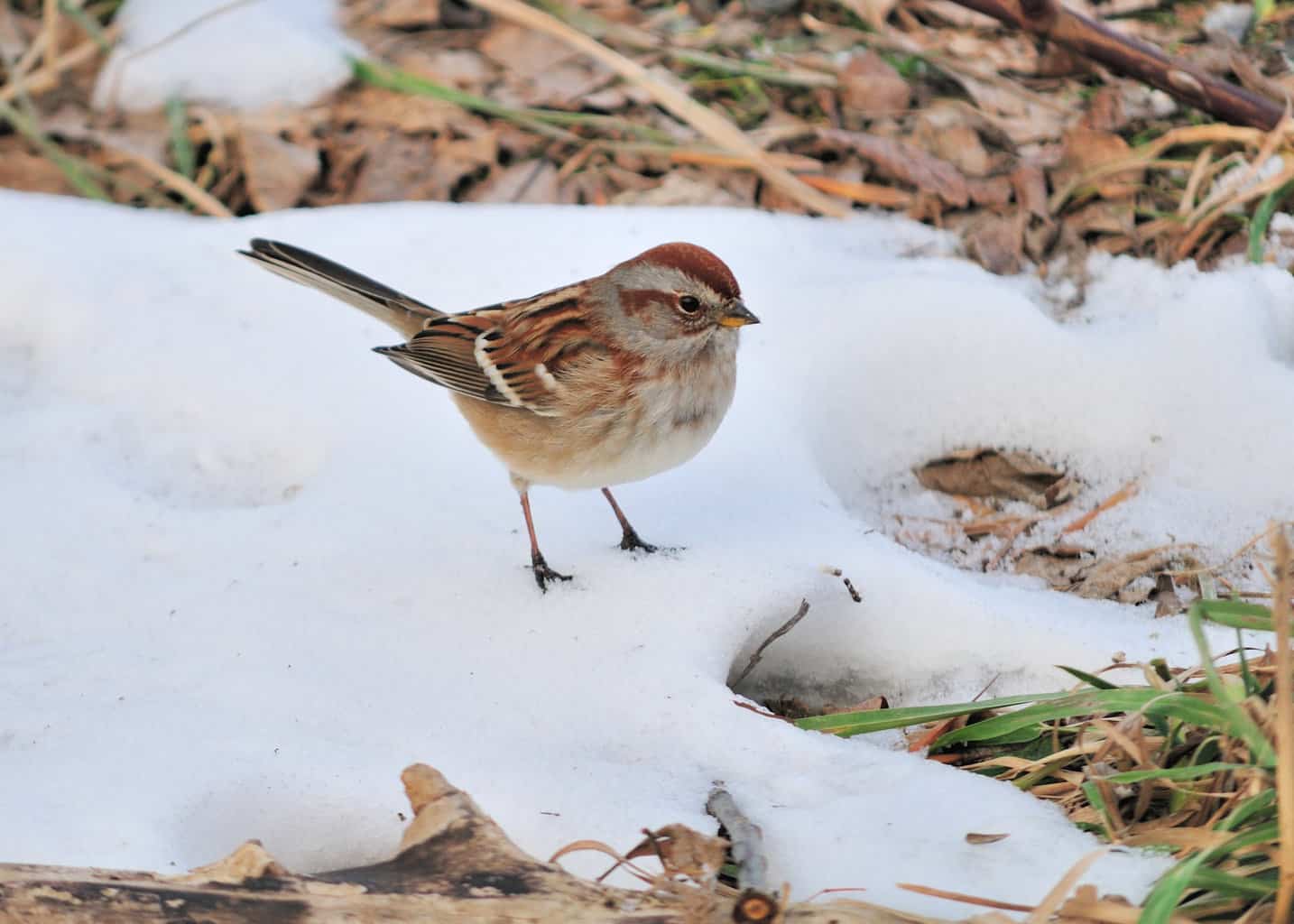
- Scientific Name: Spizelloides arborea
- Length: 5.5 in (14 cm)
- Weight: 0.5-1.0 oz (13-28 g)
- Wingspan: 9.4 in (24 cm)
American tree sparrows may be fairly common further north, but they are one of the rarest sparrows that occur in North Carolina. Because these birds are so hardy, they prefer to overwinter further north, with Virginia being the southernmost state of their regular winter range.
Only on very rare occasions do these birds dip into the balmy, warm climates of North Carolina during the winter, and as the climate warms, they’re becoming ever less frequent here.
These medium-large sparrows were named by early European settlers who felt that this bird reminded them of their native tree sparrow. This American species, however, doesn’t live much in trees and is more often found near the ground in weedy, brushy fields.
They often join mixed flocks with their cousins the field sparrow, whom they look like a larger version of.
Harris’s Sparrow
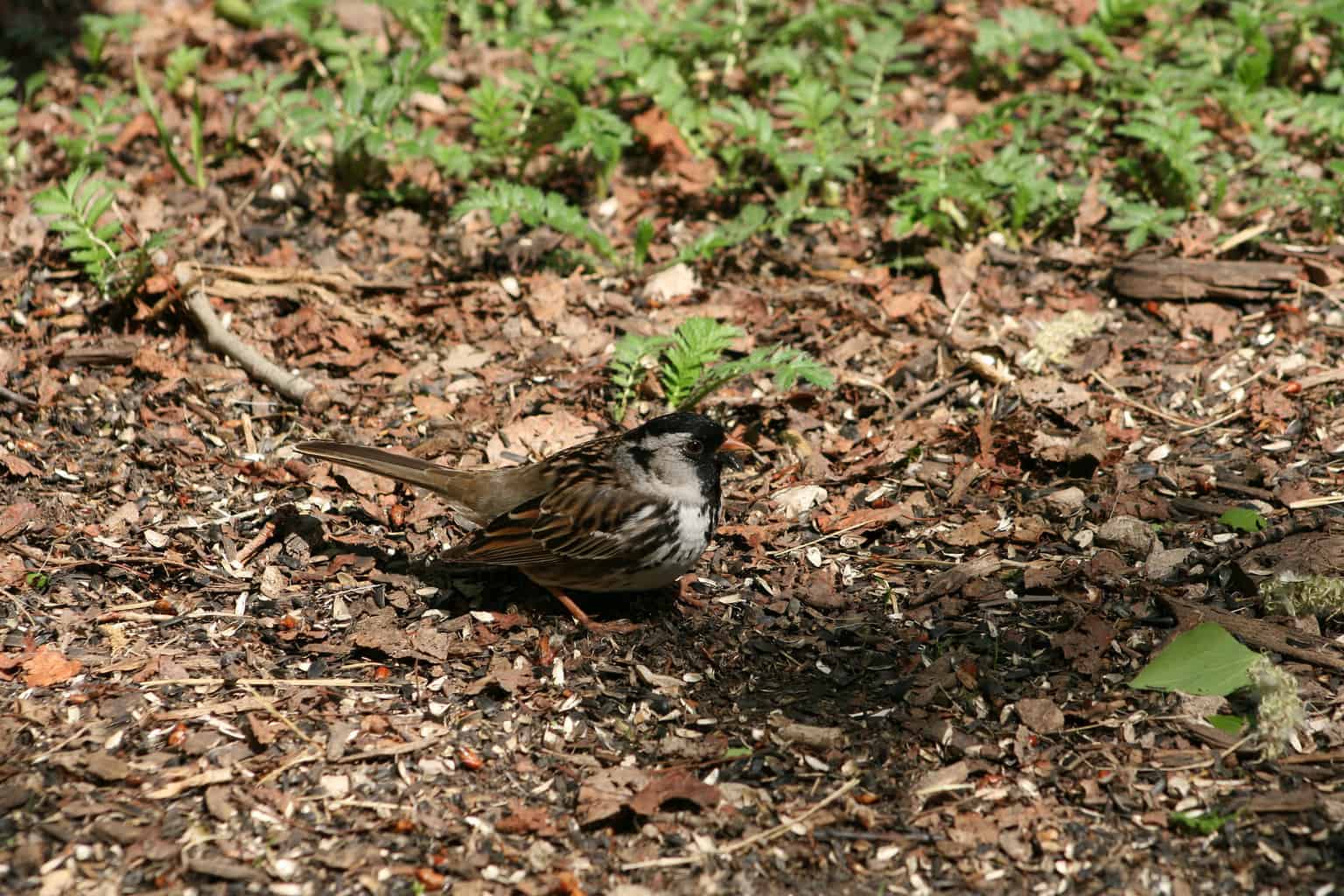
- Scientific Name: Zonotrichia querula
- Length: 6.7-7.9 in (17-20 cm)
- Weight: 0.9-1.7 oz (26-49 g)
- Wingspan: 10.6 in (27 cm)
Harris’s sparrow isn’t regularly occurring in North Carolina, but I’ve included it on this list because it is a near-threatened species that is easy to recognize, and makes for a prized sighting anywhere in the Eastern states.
Except for towhees, Harris’s sparrow is the largest of all sparrows. They are easy to recognize by their trademark black faces which are especially pronounced between March and August.
They’re essentially a bird of the central states, and only really occur this far east during spring and autumn. There have been 9 records of them in North Carolina, spanning the whole state.
Conclusion
There are a wealth of sparrow species in North Carolina, although many of them are very rare, and less common than they once were.
The loss of native grasslands to modern agriculture is largely to blame for their decline, but thankfully, ecological initiatives are attempting to keep their numbers afloat.
Sparrows make up but a fraction of the 400+ fascinating bird species in North Carolina, so don’t miss out on our dedicated guide to 25 of the most beautiful and iconic species of the ‘Old North State’.

